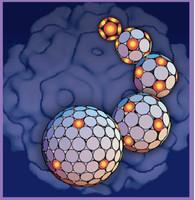-

- Zandi
Viruses infect all kinds of hosts (bacteria, plants, and animals), and with all degrees of severity (from the common cold to AIDS). Most of these viruses involve a spherical shell (capsid), which protects their genome. Amazingly enough, despite the tremendous diversity in the protein building blocks of these capsids, the structures they adopt almost always have icosahedral symmetry. I show that this striking feature is a consequence of a universal physical principle of energy minimization. In this talk, I will also discuss the structure of spherocylindrical and conical viruses. I show that the continuum theory of elastic shells combined with the nonequilibrium assembly process is able to predict the formation of structures pertinent to retroviruses (such as HIV). Our minimal model of assembly yields a unified one-dimensional phase diagram in which the appearance of spherical, irregular, conical and cylindrical structures of retroviruses is seen to be governed by the spontaneous curvature of protein subunits.

